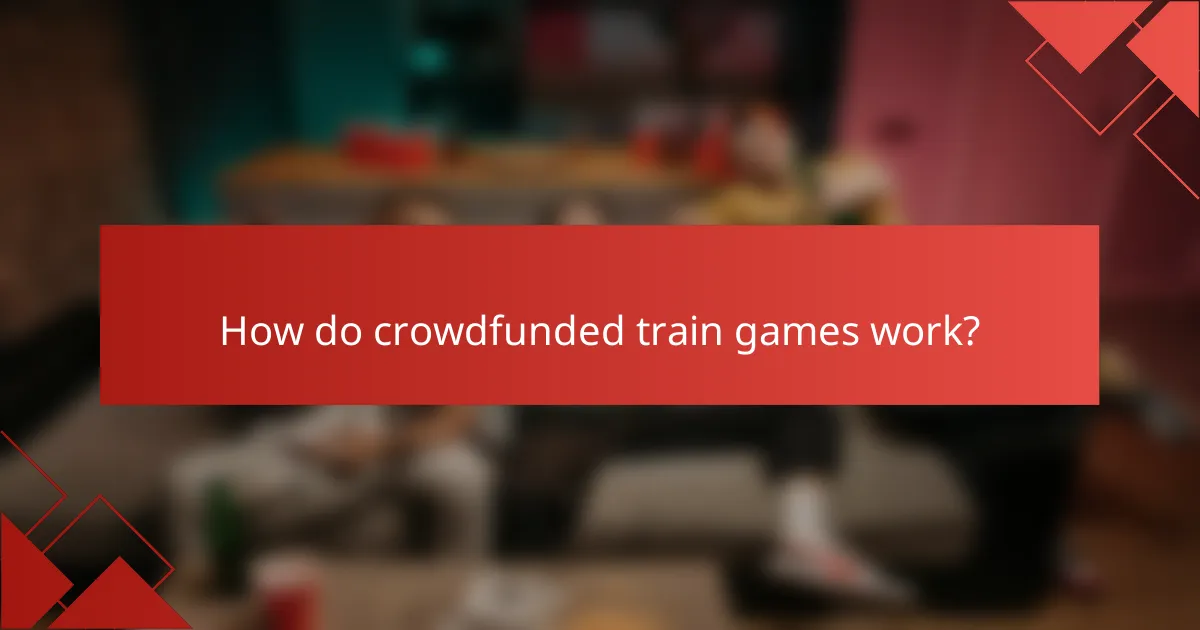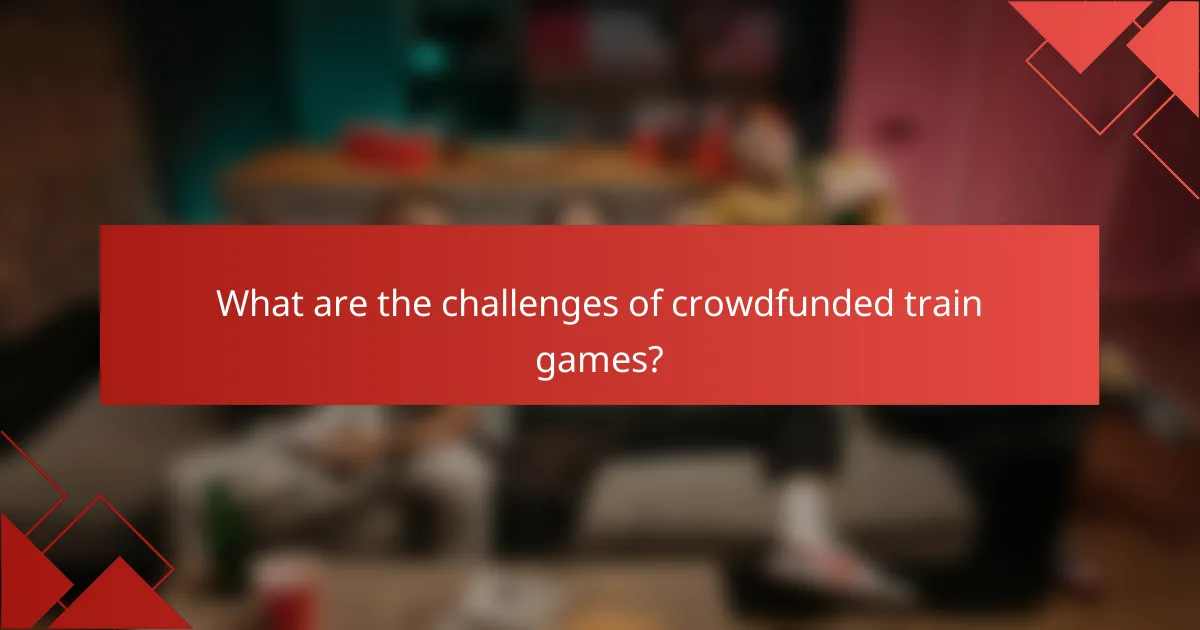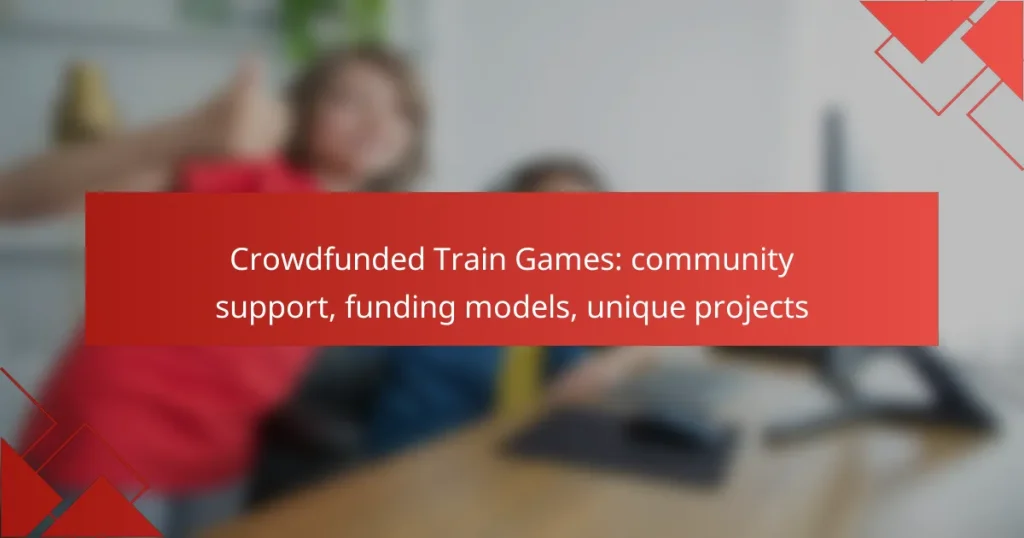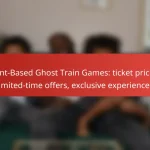Crowdfunded train games leverage community support to secure financial backing for their development, allowing creators to assess interest and minimize risks before full production. This funding model fosters direct interaction between developers and enthusiasts, resulting in unique and innovative gaming experiences. Successful projects often showcase the benefits of engaging specific audiences and utilizing creative funding strategies to enhance gameplay and development processes.

How do crowdfunded train games work?
Crowdfunded train games operate by gathering financial support from a community of enthusiasts who are interested in the development of these projects. This model allows developers to gauge interest and secure funding before committing to full-scale production, often resulting in unique and innovative gaming experiences.
Community-driven funding
Community-driven funding relies on the active participation of fans who contribute financially to support the development of train games. This approach fosters a sense of ownership among backers, as they often receive exclusive rewards or early access to the game. Engaging with the community through updates and feedback can enhance loyalty and increase the likelihood of reaching funding goals.
Platforms like Kickstarter and Indiegogo are popular for these types of projects, where developers can set funding targets and timelines. Successful campaigns typically emphasize transparency and communication to build trust and encourage contributions.
Project-based financial models
Project-based financial models vary widely, but they generally include tiered funding options that allow backers to choose their level of support. For example, a developer might offer different reward levels, from digital copies of the game to physical merchandise or even a chance to be featured in the game itself.
It’s essential for developers to clearly outline what each funding tier offers and how the funds will be used. This clarity helps potential backers understand the value of their contributions and can significantly impact the success of the campaign.
Platform-specific mechanics
Each crowdfunding platform has its own set of mechanics that can influence the success of train game projects. For instance, some platforms operate on an all-or-nothing basis, meaning that if the funding goal is not met, no funds are collected. This can create urgency but may deter some backers if the goal seems too ambitious.
Additionally, platforms may offer features like stretch goals, which incentivize backers to contribute more once the initial funding target is reached. Understanding these mechanics can help developers choose the right platform and strategy for their crowdfunded train game project.

What are the benefits of crowdfunding for train games?
Crowdfunding offers several advantages for train games, including access to specific audiences, direct interaction with supporters, and a reduction in financial risks for developers. These benefits can significantly enhance the development process and the final product.
Access to niche markets
Crowdfunding allows developers to tap into niche markets that traditional funding methods might overlook. Train games often attract dedicated enthusiasts who are eager to support projects that cater to their specific interests, such as historical accuracy or unique gameplay mechanics.
By presenting their ideas on crowdfunding platforms, developers can gauge interest and secure funding from a targeted audience. This approach can lead to a more engaged player base and a product that closely aligns with community desires.
Direct community engagement
Engaging directly with the community is a key advantage of crowdfunding for train games. Developers can receive immediate feedback on their concepts, art, and gameplay, allowing for adjustments based on supporter input. This interaction fosters a sense of ownership among backers.
Additionally, developers can build a loyal following by keeping supporters updated on progress and involving them in decision-making processes. This transparency can enhance trust and encourage further investment in future projects.
Reduced financial risk
Crowdfunding significantly lowers financial risk for developers by allowing them to secure funds before committing to full-scale production. This model helps ensure that there is sufficient interest and financial backing before resources are allocated.
Moreover, developers can use the funds raised to cover essential costs such as marketing, production, and distribution, minimizing the chance of financial loss. This approach allows for more innovative projects that might not receive traditional funding due to perceived risks.

What are successful examples of crowdfunded train games?
Successful examples of crowdfunded train games include titles that have garnered significant community support and funding, leading to unique gameplay experiences. These projects often rely on innovative funding models that engage players directly in the development process.
Railroad Ink
Railroad Ink is a popular board game that combines strategy and creativity, allowing players to build railroads and roads on a grid. The game was successfully funded through crowdfunding platforms, appealing to fans of both train and strategy games.
Players draw routes on their boards based on dice rolls, aiming to connect exits and score points. The game’s simple mechanics and engaging gameplay have made it a favorite among tabletop enthusiasts, leading to expansions and additional versions.
Train Valley
Train Valley is a train tycoon puzzle game that challenges players to build and manage a railway empire. Initially funded through Kickstarter, it offers a unique blend of strategy and simulation, appealing to both casual and hardcore gamers.
Players must efficiently lay tracks, manage resources, and optimize train routes to grow their networks. The game features a charming art style and a range of scenarios, making it accessible while still providing depth for those seeking a challenge.
Unrailed!
Unrailed! is a cooperative multiplayer game that focuses on building a train track across procedurally generated landscapes. Funded through crowdfunding, it emphasizes teamwork and quick decision-making, as players must gather resources and lay tracks before the train derails.
The game’s dynamic environments and cooperative gameplay create a fun, fast-paced experience. It encourages players to communicate effectively and adapt to changing circumstances, making it a hit at social gatherings and gaming events.

What funding models are commonly used?
Common funding models for crowdfunded train games include all-or-nothing funding, flexible funding, and equity crowdfunding. Each model offers unique advantages and considerations that can significantly impact project success and community engagement.
All-or-nothing funding
All-or-nothing funding requires projects to reach their financial goal within a set timeframe, or no funds are collected. This model encourages backers to contribute more, knowing their support is crucial for the project’s viability.
For example, if a train game project sets a goal of $50,000 and only raises $45,000, it receives nothing. This can create urgency and motivate backers to share the campaign widely to meet the target.
However, creators should be cautious about setting realistic funding goals. Too high a target may deter potential backers, while too low may not cover project costs.
Flexible funding
Flexible funding allows creators to keep whatever amount they raise, regardless of whether they meet their goal. This model can be beneficial for projects that can still proceed with partial funding.
For instance, if a train game project aims for $30,000 but only raises $20,000, the creators can still use that amount to develop the game, albeit with potentially scaled-back features. This can attract backers who want to support a project even if it doesn’t reach its full funding goal.
However, creators must communicate how they will utilize the funds effectively to maintain backer trust and support.
Equity crowdfunding
Equity crowdfunding allows backers to invest in a project in exchange for shares or equity in the company. This model can attract larger investments from individuals who believe in the long-term potential of the train game.
For example, a project might offer shares at a minimum investment of $100, giving backers a stake in the game’s success. This can create a strong community of invested supporters who are more likely to promote the game.
However, equity crowdfunding involves regulatory compliance and may require legal advice to navigate the complexities of offering shares. Creators should be prepared for ongoing communication with investors about the project’s progress and financial health.

How can communities support crowdfunded train games?
Communities can support crowdfunded train games through various means, including promoting projects on social media, providing valuable feedback during playtesting, and making financial contributions. Each of these methods plays a crucial role in the success of these unique gaming ventures.
Social media promotion
Social media is a powerful tool for raising awareness about crowdfunded train games. Communities can share project updates, trailers, and gameplay footage across platforms like Twitter, Facebook, and Instagram to reach a wider audience.
Engagement is key; communities should encourage discussions, share their excitement, and use relevant hashtags to attract attention. This grassroots promotion can significantly boost visibility and attract potential backers.
Feedback and playtesting
Providing feedback and participating in playtesting are vital ways communities can contribute to the development of crowdfunded train games. Developers often seek input on gameplay mechanics, story elements, and overall user experience to refine their projects.
Communities can organize playtesting sessions, either online or in-person, to gather diverse opinions. Constructive feedback helps creators make informed adjustments, ultimately leading to a more polished final product.
Financial contributions
Financial contributions are essential for the success of crowdfunded train games, as they directly impact the development budget. Community members can support projects by pledging on crowdfunding platforms, often receiving exclusive rewards or early access to the game.
It’s important for backers to assess the funding goals and stretch goals of a project. Contributing at different levels can unlock additional content or features, enhancing the overall gaming experience while ensuring the project’s viability.

What are the challenges of crowdfunded train games?
Crowdfunded train games face several challenges that can impact their success, including market saturation, project management issues, and community expectations. Understanding these obstacles is crucial for developers and backers alike to navigate the crowdfunding landscape effectively.
Market saturation
The gaming market, particularly for train simulation and strategy games, has become increasingly crowded. With numerous projects vying for attention, it can be difficult for new entrants to stand out and attract sufficient funding. Developers need to clearly define their unique selling points to differentiate their games from existing offerings.
To combat saturation, consider focusing on niche themes or innovative gameplay mechanics. Engaging with specific communities can also help in building a loyal fan base that is more likely to support the project financially.
Project management issues
Effective project management is critical for the success of crowdfunded train games. Many developers underestimate the time and resources required to deliver a polished product, leading to delays and unmet expectations. Setting realistic timelines and budgets is essential to avoid common pitfalls.
Using project management tools can help streamline development processes and keep backers informed. Regular updates and transparent communication can build trust and maintain community interest throughout the development cycle.
Community expectations
Backers of crowdfunded train games often have high expectations regarding game quality and features. Meeting these expectations can be challenging, especially when balancing ambitious goals with limited resources. Developers should engage with their community early and often to gauge interest and gather feedback.
Establishing clear communication about what backers can realistically expect helps manage these expectations. Offering regular updates, involving the community in decision-making, and being transparent about challenges can foster a supportive environment that enhances project viability.


